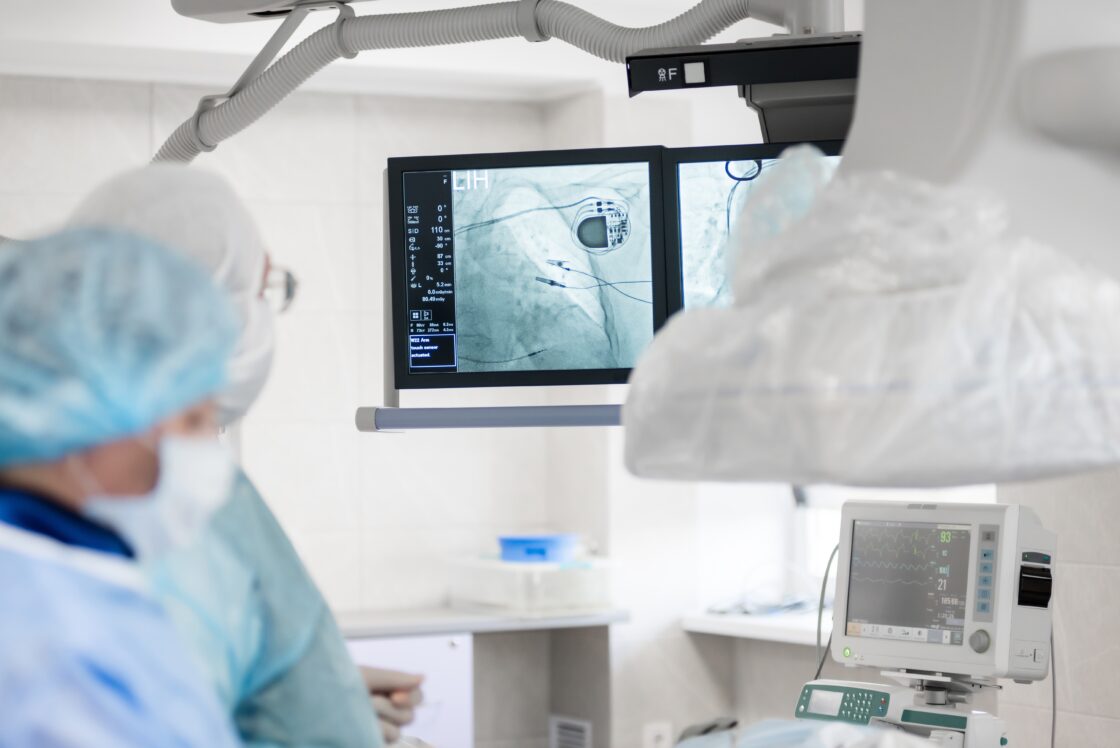Optimising Infection Prevention in Cardiac Device Patients Using the BLISTER Score
This collaboration between Barts Health NHS Trust and NHS Supply Chain has huge potential to direct cost-effective use of novel antimicrobial technology. Our value based procurement model demonstrates how the BLISTER risk score can identify which cardiac device patients would most benefit from antimicrobial envelopes, delivering improved outcomes alongside considerable associated healthcare savings.
Dr. Edd Maclean, Cardiology Research Fellow, St. Bartholomew’s Hospital
1Cardiac implantable electronic device (CIED) infections pose significant risks to patients and are an additional strain on healthcare systems. Leveraging the BLISTER score to guide antimicrobial envelope usage, this study demonstrates a practical, cost-effective approach that improves patient outcomes while delivering substantial healthcare savings.
Overview
NHS Supply Chain and Barts Health NHS Trust collaborated on a study to evaluate the cost-effective use of an antimicrobial envelope in high-risk CIED patients. This study utilised the BLISTER score, a novel risk assessment tool, to identify patients who would benefit most from the antimicrobial envelope.
This Value Based Procurement (VBP) pilot demonstrates success in reducing infection rates, enhancing patient outcomes, and achieving significant cost savings.
Key outcomes included:
- Enhanced Clinical Outcomes: Patients experienced fewer infections and related complications.
- Reduced Readmissions: The targeted use of the antimicrobial envelope resulted in substantial cost savings by decreasing the need for readmissions, device extractions, and reimplantation.
- Reduced Infection Rates: Lower infection-related hospital stays.
- Increased Bed Capacity: Including intensive care units, allowing more patients to receive timely care.
- Standardised Practice: Clear infection risk analysis is applied within trusts and systems.
Join the Future of Health Care
By adopting the BLISTER score to guide antimicrobial envelope usage in high-risk CIED patients, your trust can achieve significant cost reduction in total care pathway and increase bed capacity.
Contact our Care Pathway Team to conduct tailored financial modelling.
Enquire Now About Adopting the BLISTER Score
Complete our two minute enquiry form and your regional Care Pathway Specialist or Clinical Care Pathway Manager will respond with further details.
As the Care Pathway Team, we are supporting this work stream with ambitions aligned to the recently published NHSE Elective Recovery Targets, aiming to address the backlog for elective procedures.
The Challenge
2CIED infection is a serious complication of device therapy, with significantly increased likelihood of patient mortality, impact on quality of life, and healthcare costs. The incidence of CIED infections are rising, due to the growing use of complex devices, repeated procedures on device pockets, and the rise in related health conditions.
3In the UK, around 60,000 CIED procedures are performed annually, and 1-4% of patients develop an infection within 12 months. If the infected CIED cannot be extracted safely, mortality exceeds 30%. In patients with high-energy devices (such as implantable cardioverter defibrillators (ICDs), the cost of an infection can exceed £50,000, involving an extraction procedure, a device reimplantation, and a hospital stay of 4-6 weeks.
To tackle this issue, Barts Health NHS Trust recognised the need for effective and cost-efficient infection prevention strategies that prioritise high-risk patients while optimising healthcare resources.

The Solution
The BLISTER score was created by Clinicians from the Barts Heart Centre at St Bartholomew’s Hospital. This is a novel, externally validated predictor of infection in a real-world cardiac implantable electronic device population. Risk score points are assigned according to patient parameters.
The risk assessment tool is designed to predict the likelihood of infection in CIED patients within 12 months of a procedure. It considers various patient and procedural factors, including age, renal impairment, and the complexity of the device implant.
A BLISTER score cut-off of 6 or higher is a powerful prognostic marker and incorporates key high-risk subgroups in their entirety, including all patients undergoing cardiac resynchronisation therapy (CRT) generator change, lead extraction, or a re-intervention within two years.
Patients with a BLISTER score of 6 or higher are identified as high-risk and are recommended to receive the antimicrobial envelope to prevent infections.
The cost modelling indicates that a BLISTER score threshold of 6 or higher can be used to allocate the antimicrobial envelope within established willingness-to-pay thresholds (i.e. below the NICE target of £20,000 per Quality-Adjusted Life Year (QALY) gained).
Supporting Evidence: The WRAP-IT Trial
4The WRAP-IT trial was a large, international study that evaluated the effectiveness of the antimicrobial envelope in reducing infections in patients with CIEDs. The trial included 6,900 patients and demonstrated that the use of the antimicrobial envelope significantly lowered the incidence of infections within a year of the procedure. This evidence supports the use of the antimicrobial envelope to improve patient outcomes and reduce healthcare costs.
While the envelope is currently too costly for widespread use in the UK and there are no National Institute for Health and Care Excellence (NICE) guidelines in place yet, risk scoring can help ensure it is utilised within the appropriate clinical cohort of patients. This underscores the importance of embedding cost-effective methods to maximise the benefits of this technology.
The evidence suggests that a risk score could help identify which CIED patients would benefit most from this important technology.
The Aim
The aim of this Value Based Procurement pilot was to:
- Enhance clinical outcomes by reducing infection rates.
- Deliver healthcare system cost savings from reducing readmission, device extraction and reimplantation procedures.
- Increase hospital capacity (including intensive care beds) as a result of reduced infection-associated hospitalisation.
- Standardise practice within trusts and systems by applying clear infection risk analysis.
The Results
These results highlight the financial benefits of using the antimicrobial envelope for high-risk patients. By reducing infections, the envelope improves patient outcomes and reduces costs. The detailed breakdown of costs following an infection underscores the significant expenses that can be avoided with effective infection prevention strategies.
- Cost of a CIED Infection (without antimicrobial pouch): £52,970
- Potential saving per prevented infection: £34,986
- Number needed to treat: 30 (an antimicrobial envelope will prevent one infection in every 30 patients at this level of risk.)
- Final saving per patient: £1,166.
Breakdown of costs following an infection:
| Cost Element | Amount (£) |
| Replacement device cost | £10,325 |
| Extraction procedure costs | £5,064 |
| Reimplantation procedure costs | £4,057 |
| Ward costs as the patient recovers | £15,840 |
| Pharmacy costs | £500. |
Having adopted the BLISTER score as a risk stratification tool at St. Bartholomew’s Hospital, the antimicrobial envelope is now used in all patients with a BLISTER score of 6 or above, with significant reductions in the incidence of device infection, patient mortality, and healthcare costs.
Operational Benefits
The integration of the BLISTER score and Antimicrobial Envelope delivered wide-ranging benefits:
Reduction in total costs within the patient pathway: By preventing infections and reducing the need for additional procedures, the total costs within the patient care pathway are significantly reduced.
Increased bed capacity: With reduced infection-associated admissions, hospital bed capacity is increased.
Reduction in device costs: By reducing the need for reimplantation procedures.
Standardised practice: Consistent implementation of risk scoring to facilitate antimicrobial envelope use, resulting in standardised practice across the trust.
Healthcare system savings: The use of the antimicrobial envelope leads to fewer admissions, device extraction and reimplantation procedures.
*Savings to wider health economy: The use of the antimicrobial envelope generates £103,268 annually for Barts Health NHS Trust.
*These savings are the efficiency and productivity savings from BARTS Health NHS Trust over a 12-month period 2024-2025.
Join the Future of Health Care
By adopting the BLISTER score to guide antimicrobial envelope usage in high-risk CIED patients, your trust can achieve significant cost reduction in total care pathway and increase bed capacity.
Contact our Care Pathway Team to conduct tailored financial modelling.
As the Care Pathway Team, we are supporting this work stream with ambitions aligned to the recently published NHSE Elective Recovery Targets, aiming to address the backlog for elective procedures.
References
- https://www.ahajournals.org/doi/full/10.1161/CIRCEP.123.012446
- https://www.nejm.org/doi/full/10.1056/NEJMoa1901111
- https://www.ahajournals.org/doi/full/10.1161/CIRCEP.123.012446
- https://www.nejm.org/doi/full/10.1056/NEJMoa1901111
Links section
-
Care Pathway Team Contact Details
Follow this link to find contact details for your regional Care Pathway Specialist and Clinical Nurse Advisors.
-
Value Based Procurement Case Studies
Follow this link to view more real world pilots implementing VBPs.

